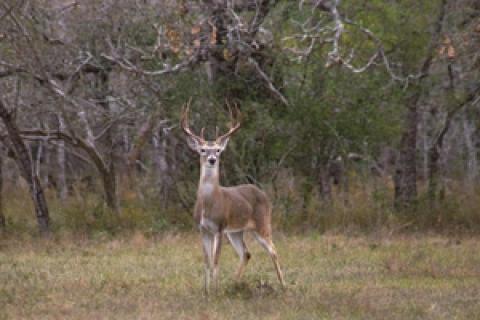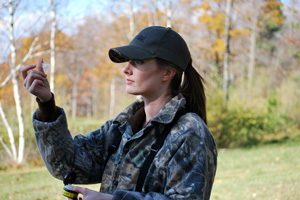
One of the best things about spring is it's the best time of year to set up for fall whitetail hunting. If you've done your winter homework, you should know the ins and outs of your deer hunting property by now and have a pretty good idea of how the deer using your property use it. The trick is learning how to set-up for the kill, spring is a great time to do it, and the answer is blown in the wind.
Why Wind is Important
 |
| Mature bucks have fully developed "wind smarts" compared to young deer, who are still learning how wind is important to their survival. |
Absolutely nothing is as important to hunting deer (particularly mature deer) as the wind. A major portion of a whitetail's brain is dedicated to smell, and as any hunter knows, it shows. Deer use their noses to under-stand the world they live in and to stay alive. Their sight and hearing senses are plenty keen, but neither even comes close to their sense of smell. They "see" with their nose, and move with their nose, and eat with it as well.
Deer use the wind like teens use text messaging — to stay in touch with their world. Yet all deer do not use wind the same way or with the same skill. It's a learned skill in the whitetail world. Young deer are still learning how to play the wind and frequently seem to ignore what the wind is telling them. In fact, it takes a number of years for a deer to develop a full compliment of "wind smarts." Mature deer stay alive by minimizing movement and identifying danger long before danger identifies them; in every-thing they do, they're maximizing olfactory input and move about only with the wind in their favor. Older deer know where they want to get to and they use their noses to get there safely
.
Smart hunters know that hunting the wind means much more than setting a stand on the downwind side of a deer trail or food plot; they know that the wind will determine how a mature buck will move from area to area, where he will bed, and how he will escape danger. They know that a mature buck uses his nose to "see" the woods like a hunter uses his binoculars to study a drainage basin. They also know that the only way to "beat" a mature buck's nose is to stay downwind or stay in camp.
Air Movement
Air moves across a property like water in a stream. On relatively wide unobstructed areas, stream water is smooth flat and relatively slow. Add a boulder to flat water and you create turbulence as the water courses around, or over, the obstruction. Channel all the water into an 8-foot space along a rock wall and the water will accelerate into a rapidly flowing run; widen the stream and it slows down again. The same can be said of air moving over land.
Conifer thickets, outcrops, gulches and open fields all affect how air will move across a property. In spite of what the weatherman says about wind direction, wind passing over natural topography will ebb and flow, swirl and double back, and pull a dozen other nasty tricks on unsuspecting hunters; deer know this, and know how to use their nose to stay alive.
Wind Mapping
We pay attention to how wind moves over a piece of property because deer do the same. We use wind floaters and smoke bombs and bubbles to tell us how the wind moves. Deer use their noses. We map the wind to kill deer; they map the wind to stay alive. We've been doing this for about 10 years, they for about 10 thousand. No contest, they will beat you every time in a fair fight.
 |
| Use wind floaters or bubbles to understand how wind interacts with a piece of ground or in your stand. |
But you have to try, and you have to do everything you can to understand how wind interacts with a piece of ground and turn it to your advantage. Creating wind maps is one of the most important measures a hunter can take to ensure hunting success on a given property.
We blow bubbles (auto gun or wand) or set off smoke bombs or use wind floaters to see how the wind moves across a given stretch of property. We follow the wind markers as far as we can, then release another batch and follow them, marking an aerial photo as we go. We stop when we run out of property. Then we do it all over again from another starting place, making sure the wind has held steady.
Check Your Stands
If you don't have the time or energy to wind map your entire property, you should at least map your stand locations. You absolutely need to know what will be happening on a given stand, with any given wind. Knowing exactly where that big buck will catch your scent can mean the difference between a dead deer and a flag waving goodbye.
Sometimes you can beat the wind by moving your stand 5 feet higher (or lower) on the tree. Try it and light a few smoke bombs to check it out. Sometimes moving it 10 feet to the right or left will do the trick. You will never know until you try.
There are some stands where the wind always seems to be on the back of your neck, no matter which direction the wind is out of. These stands exist everywhere and should be avoided like the plague. We call them "swirlers," and for whatever reason, the wind always seems to be changing when you hunt them. Chances are, it has something to do with the terrain, and the best way to deal with them is to avoid the location altogether. If it's any consolation, deer don't like hanging around these areas either as they have trouble keeping track of danger in swirling winds.
What you are looking for is "clean air" to hang your stands in and early spring is as good a time as any to find it. Clean air flows smoothly over the land and if your stand is set in the right place, it will carry your scent off into a safe location like across a lake or highway or open field — somewhere where a deer is not likely to approach from. It's not too early to set up for fall.
Make no mistake, when it comes to hunting mature bucks, it is all about the wind. Wind dictates how deer move across the landscape, where they bed, and how they will feed. When hunting big bucks, it's not enough to know what the weatherman called for, you need to know exactly what the wind will be doing on your hunting property and hunt accordingly. Wind is the key element in big buck hunting success and setting up in spring for next fall's hunt will give the deer plenty of time to get over the disruption.
- 4293 views

